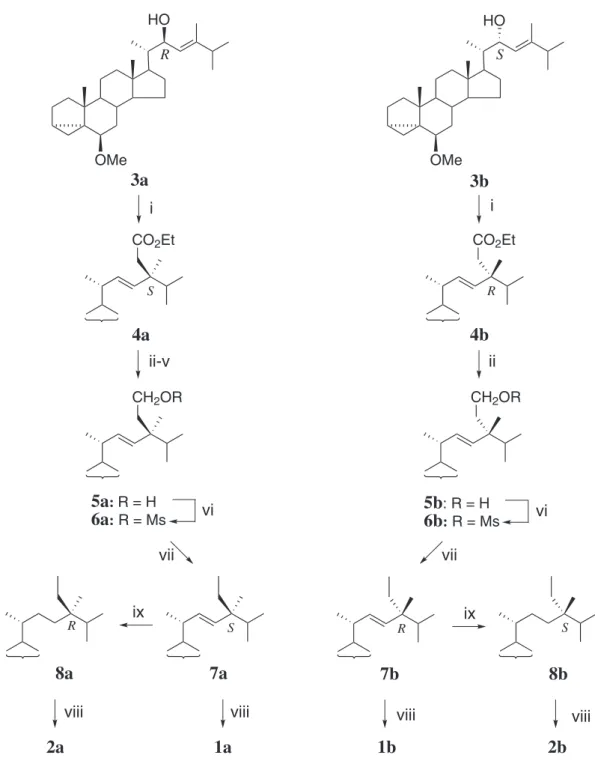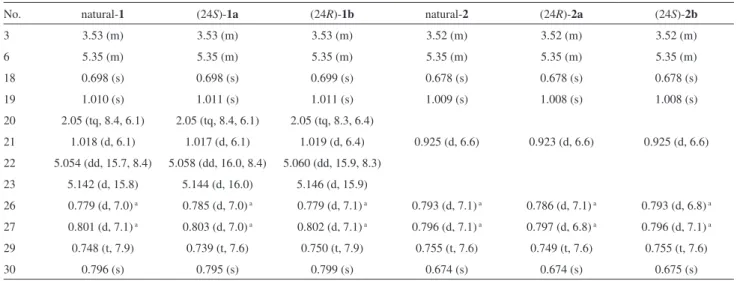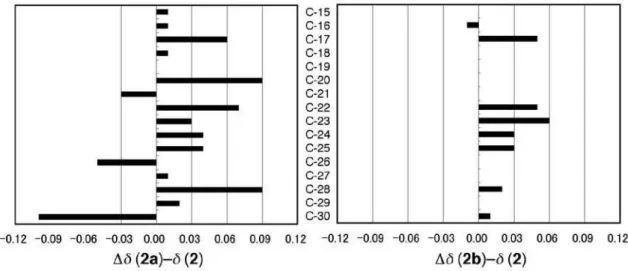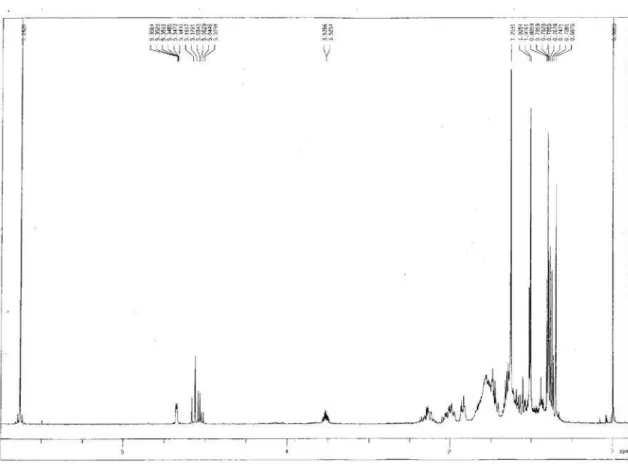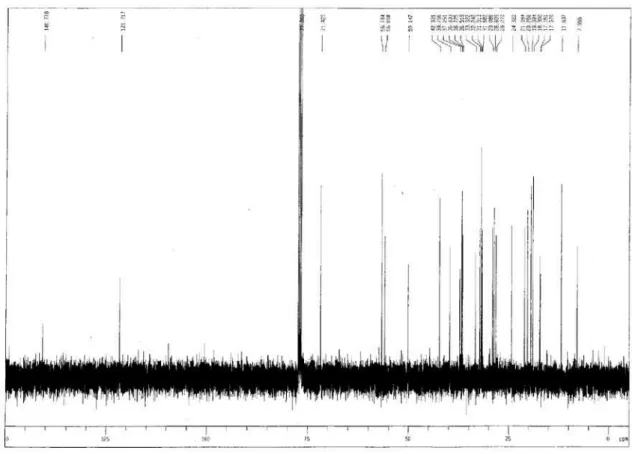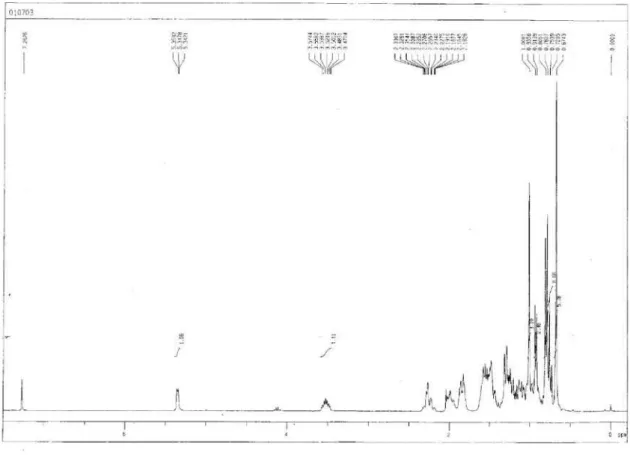Short Report
S
J. Braz. Chem. Soc., Vol. 22, No. 5, 997-1004, 2011.Printed in Brazil - ©2011 Sociedade Brasileira de Química 0103 - 5053 $6.00+0.00
*e-mail: cduqueb@unal.edu.co, cduqueb@etb.net.co
C-24 Stereochemistry of Marine Sterols: (22
E
)-24-Ethyl-24-methylcholesta-5,22-dien-3
β
-ol
and 24-Ethyl-24-methylcholest-5-en-3
β
-ol
Shizue Echigo,a Leonardo Castellanos,b Carmenza Duque,*,b Hidehiro Uekusa,a Noriyuki Haraa and Yoshinori Fujimotoa
aDepartment of Chemistry and Materials Science, Tokyo Institute of Technology,
Meguro, 152-8551, Tokyo, Japan
bDepartamento de Química, Universidad Nacional de Colombia,
AA 14490, Bogotá, Colombia
As conigurações dos carbonos C-24 nos compostos (22E
)-24-etil-24-metilcolesta-5,22-dien-3β-ol (1) e 24-etil-24-metilcolest-5-en-3β-ol (2), isolados da esponja do caribe colombiano
Topsentia ophiraphidites foram determinadas como R e S, respectivamente, com base na comparação
dos seus dados de RMN com aqueles de amostras de conigurações já deinidas 24R e 24S, as
quais foram sintetizadas em rotas envolvendo ortoésteres provenientes do rearranjo de Claisen de álcoois D23-22 alílicos. Este é primeiro estudo de síntese, em que o rearranjo de Claisen é utilizado
para introduzir um centro quaternário em C-24, de maneira estereoespecíica e com rendimento aceitável. Análises por difração de raio X de 1 conirmaram essas atribuições estereoquímicas.
The C-24 conigurations of (22E)-24-ethyl-24-methylcholesta-5,22-dien-3β-ol (1) and 24-ethyl-24-methylcholest-5-en-3β-ol (2), isolated from the Colombian Caribbean sponge Topsentia ophiraphidites, were determined to be R and S, respectively, by comparing their NMR data with those of stereodeined (24R)- and (24S)-samples that were synthesized in routes involving the
orthoester Claisen rearrangement of D23-22-allylic alcohols. This is the irst synthetic study where
the Claisen rearrangement is used to introduce a C-24 quaternary center in a stereospeciic manner with acceptable yield. X-ray analysis of 1 conirmed these stereochemical assignments.
Keywords: 24-ethyl-24-methylcholesterol, 24-ethyl-24-methylcholesta-5,22-dien-3β-ol,
Topsentia ophiraphidites, marine sterol, orthoester Claisen rearrangement
Introduction
It is well known that marine organisms such as sponges and corals are rich sources of uniquely modiied sterols in the side-chain.1 Among these sterols, C-24 dialkylated
sterols are relatively limited. Djerassi’s group reported the isolation of (22E)-D22-24-ethyl-24-methylcholesterol (1),
(22E)-D22-24-ethyl-24-methylcholestanol,
24-ethyl-24-methylcholesterol (2),and (22E)-D22,25
-24-ethyl-24-methylcholesterol from a sponge, Pseudoaxinyssa sp.2,3
Although they briely mentioned the C-24 conigurations of these sterols, details of the stereochemical assignment have not been reported.3 They also reported the preparation
of stereochemically unestablished C-24 diastereomers of 12
and stereochemically defined, C-24 diastereomers of
24-ethyl-24-methylcholestanols.4 Recently, sterol 1 was
isolated from the marine sponge Psammocinia bulbosa
and its C-24 coniguration was inferred as R without any
discussion on the stereochemistry.5 Furthermore,
24-ethyl-24-methylcycloartane triterpenoids were isolated from higher plants, Coelogyne uniflora (Orchidaceae)6 and Skimmia wallichii (Rutaceae).7 In a previous paper we
reported the isolation of a number of multiply alkylated sterols, including compounds 1 and 2, from the Colombian
Caribbean sponge, Topsentia ophiraphidites.8 In particular,
compound 1 was a major sterol constituent (ca. 40% of the
total sterol). With sizeable amounts of compounds 1 and 2 in hand, we undertook a study to elucidate their C-24
conigurations. In this paper we report a stereochemical determination at C-24 of 24-ethyl-24-methylsterols 1
and 2 (Figure 1), along with the 13C NMR data for the
Results and Discussion
In order to determine the C-24 coniguration of 1
and 2, we decided to synthesize the stereochemically
defined (24S)- and (24R)- (22E)-D22
-24-ethyl-24-methylcholesterols (1a and 1b), and (24R)- and (24S
)-24-ethyl-24-methylcholesterols (2a and 2b). A method
based on Claisen rearrangement appeared to be attractive for the stereoselective construction of the C-24 dialkyl side chains, although the application of this method to the construction of a C-24 quaternary center is unprecedented. The Johnson orthoester procedure and the Ireland variant of Claisen rearrangement are frequently employed for the synthesis of stereo-deined C-24 mono-alkylated sterol side-chains.9-11 We also utilized the orthoester Claisen
rearrangement for the stereoselective synthesis of (24R)-
and (24S)- (22E)-24-isopropenyl-22-dehydrocholesterol
and 24-isopropenylcholesterol, another multiply alkylated sterol of T. ophiraphidites.12
The synthetic route to 1a and 1b, and 2a and 2b is shown
in Figure 2. The required starting materials, (22R)-allylic
alcohol 3a and (22S)-allylic alcohol 3b, for the orthoester
Claisen rearrangement were obtained stereoselectively from the corresponding enone13-15 by reduction using
DIBAL-H and L-selectride, respectively.14 Treatment of 3a
with triethyl orthoacetate and propionic acid in reluxing xylene gave a mixture of the desired rearranged product
4a (not isolated as such) and by-products containing the
22-propionate ester of 3a. The C-24 epimer of 4a was not
formed in the rearrangement reaction, since careful TLC and NMR analysis revealed that compounds 4a and 5a were
free from 4b and 5b, respectively. The 24S coniguration of
4a was assumed on the basis of the preferred transition state
conformation for the rearrangement reaction (Figure S1) that is analogous to the conformation well established for the 3,3-sigmatropic reactions of steroidal 23-ene-22-allylic alcohols.16 The 24S coniguration of 4a was ascertained by
the eventual conversion of 4a to the (24S)-diastereomer 1a
(vide infra). The product mixture containing 4a was reduced
with LiAlH4 and then the resulting alcohol mixture was acetylated to facilitate the separation. Hydride reduction of the puriied acetate gave the primary alcohol 5a in 24%
yield from 3a. Deoxygenation of the C-29 hydroxy group
of 5a was achieved by super-hydride reduction of the
corresponding mesylate 6a to givethe i-methyl ether 7a.
Removal of the i-methyl ether of compound 7a furnished
the (24S)-diastereomer 1a. Hydrogenation of 7a gave the
saturated (24R)-diastereomer 8a which was converted to the
(24R)-diastereomer 2a upon deprotection of the i-methyl
ether. Application of the same sequence of reactions to the (22S)-allylic alcohol 3b, furnished the (24R)-diastereomer
1bvia the intermediates 4b, 5b, 6b and 7b. Hydrogenation
of 7b gave 8b, which furnished the (24S)-diastereomer 2b
by regeneration of the D5-3β-hydroxy system.
The 1H and 13C NMR spectroscopic data of the synthetic
diastereomers 1a and 1b are listed in Tables 1 and 2,
respectively, together with those of the sterol 1 isolated
from T. ophiraphidites. The 1H and 13C signals of 1a and 1b were unambiguously assigned on the basis of 2-D (H-H
COSY, HMQC and HMBC) NMR spectra. For example, in the HMQC spectrum of 1a, H-22 (d 5.058) and H-23 (d 5.144) were correlated with C-22 (d 134.9) and C-23 (d 134.6), respectively, while in the HMBC spectrum, correlation peaks were observed from 21-H3 (d 1.017) to
C24
C24
HO HO
1:24ξ (natural)
1a: 24S
1b: 24R
26 27 28
29
30
2:24ξ (natural)
2a: 24R
2b: 24S
24
C24
C24
Echigo et al. 999 Vol. 22, No. 5, 2011
C-17, C-20 and C-22, H3-26/H3-27 (d 0.785 and 0.803) to C-24 and C-25, H3-29 (d 0.739) to C-24 and C-28, and H3 -30 (d 0.795) to C-23, C-24, C-25 and C-28. The 1H NMR
data of the epimers were closely similar to each other. However, careful comparison of the spectra revealed that
1a or 1b showed an appreciable difference in the chemical
shifts of 29-H3 (Dd 0.011 ppm), and natural 1 seemed to be
identical with the (24R)-diastereomer 1b in this regard. As
shown in Table 2, the 13C data were much more diagnostic
for the identiication of the diastereomers 1a and 1b. The
C-24 signal showed the largest difference (0.19 ppm) between the diastereomers and the C-29 and C-28 signals
HO
R
i
CO2Et
S
4a
ii-v
CH2OR
5a
: R = H6a
: R = Ms vivii
S
1a
7a
viii
CO2Et
R
4b
CH2OR
R
5b: R = H
6b
: R = Ms7b
ix R8a
2a
S8b
1b
3b
2b
3a
OMe HO S OMe ix iviii viii viii
vi
vii ii
Reagents: i) MeC(OEt)3, propionic acid, ii) LiAlH4, iii) Ac2O, Py, iv) separation, v) LiAlH4, vi) MsCl, Py, vii) Super hydride, viii) p-TsOH/aq. dioxane, ix) H2, Pd/C.
Table 1.1H NMR spectroscopic data (400 MHz, in CDCl
3) for compounds 1, 1a, 1b, 2, 2a and 2b
No. natural-1 (24S)-1a (24R)-1b natural-2 (24R)-2a (24S)-2b
3 3.53 (m) 3.53 (m) 3.53 (m) 3.52 (m) 3.52 (m) 3.52 (m)
6 5.35 (m) 5.35 (m) 5.35 (m) 5.35 (m) 5.35 (m) 5.35 (m)
18 0.698 (s) 0.698 (s) 0.699 (s) 0.678 (s) 0.678 (s) 0.678 (s)
19 1.010 (s) 1.011 (s) 1.011 (s) 1.009 (s) 1.008 (s) 1.008 (s)
20 2.05 (tq, 8.4, 6.1) 2.05 (tq, 8.4, 6.1) 2.05 (tq, 8.3, 6.4)
21 1.018 (d, 6.1) 1.017 (d, 6.1) 1.019 (d, 6.4) 0.925 (d, 6.6) 0.923 (d, 6.6) 0.925 (d, 6.6) 22 5.054 (dd, 15.7, 8.4) 5.058 (dd, 16.0, 8.4) 5.060 (dd, 15.9, 8.3)
23 5.142 (d, 15.8) 5.144 (d, 16.0) 5.146 (d, 15.9)
26 0.779 (d, 7.0) a 0.785 (d, 7.0) a 0.779 (d, 7.1) a 0.793 (d, 7.1) a 0.786 (d, 7.1) a 0.793 (d, 6.8) a 27 0.801 (d, 7.1) a 0.803 (d, 7.0) a 0.802 (d, 7.1) a 0.796 (d, 7.1) a 0.797 (d, 6.8) a 0.796 (d, 7.1) a 29 0.748 (t, 7.9) 0.739 (t, 7.6) 0.750 (t, 7.9) 0.755 (t, 7.6) 0.749 (t, 7.6) 0.755 (t, 7.6)
30 0.796 (s) 0.795 (s) 0.799 (s) 0.674 (s) 0.674 (s) 0.675 (s)
aAn upield resonance was tentatively assigned to H 3-26.
Table 2.13C NMR spectroscopic data (100 MHz, in CDCl
3) for compounds 1, 1a, 1b, 2, 2a and 2b
No. natural-1 (24S)-1a (24R)-1b natural-2 (24R)-2a (24S)-2b
1 37.3 37.3 37.3 37.3 37.3 37.3
2 31.7 31.7 31.7 31.7 31.7 31.7
3 71.8 71.8 71.8 71.8 71.8 71.8
4 42.3 42.3 42.3 42.3 42.3 42.3
5 140.8 140.8 140.8 140.8 140.8 140.8
6 121.7 121.7 121.7 121.7 121.7 121.7
7 31.9 31.9 31.9 31.9 31.9 31.9
8 31.9 31.9 31.9 31.9 31.9 31.9
9 50.2 50.2 50.2 50.1 50.1 50.2
10 36.5 36.5 36.5 36.5 36.5 36.5
11 21.1 21.1 21.1 21.1 21.1 21.1
12 39.7 39.7 39.7 39.7 39.8 39.8
13 42.2 42.2 42.2 42.3 42.3 42.3
14 56.9 56.9 56.9 56.8 56.8 56.8
15 24.3 24.4 24.3 24.3 24.3 24.3
16 28.9 28.9 28.9 28.3 28.3 28.3
17 56.1 56.1 56.1 56.0 56.0 56.0
18 12.1 12.1 12.1 11.8 11.8 11.8
19 19.4 19.4 19.4 19.4 19.4 19.4
20 40.8 40.8 40.8 36.6 36.7 36.6
21 21.3 21.4 21.3 18.9 18.9 18.9
22 134.8 134.9 134.8 29.0 29.1 29.1
23 134.7 134.6 134.7 32.2 32.2 32.3
24 35.7 35.9 35.7 36.8 36.8 36.8
25 41.1 41.1 41.1 33.3 33.3 33.3
26 17.3a 17.3a 17.3a 17.1a 17.1a 17.2a
27 17.9a 18.0a 17.9a 17.2a 17.2a 17.2a
28 31.8 31.6 31.7 28.6 28.7 28.6
29 8.7 8.5 8.6 7.9 8.0 7.9
30 18.3 18.3 18.3 20.4 20.3 20.4
aAn upield resonance was tentatively assigned to C-26 (The C-26 and C-27 signals were not necessarily correlated to the H
Echigo et al. 1001 Vol. 22, No. 5, 2011
were different by more than 0.10 ppm, and this much difference would be suficient for the identiication of the diastereomers. The 13C data of natural 1 met with those of
the (24R)-diastereomer 1b. It was, therefore, concluded
that the sterol 1 isolated from T.ophiraphidites has 24R
coniguration. The sterol 1 isolated from Pseudoaxinyssa sp.3
was also identiied as the (24R)-diastereomer 1b, since
the published 1H NMR data (adjusted by the addition of
0.005 ppm) was much closer to those of 1b, rather than
those of 1a. The sterol 1 isolated from P. bulbosa could be
assigned as the (24R)-diastereomer 1b, since the reported
13C shifts of C-24, C-28 and C-29 resembled the values of
1b rather than those of 1a.
The 1H and 13C NMR spectroscopic data of the sterol 2
isolated from T. ophiraphidites and the synthetic
24-diasteromers 2a and 2b are listed in Tables 1 and 2,
respectively. The 1H and 13C signals of 2a and 2b were
unambiguously assigned as described for 1a and 1b. For
example, in the HMBC spectrum of 2a, H3-21 (d 0.923) was correlated with C-17, C-20 and C-22, H3-26/H3-27 (d 0.786 and 0.797) with C-24 and C-25, H3-29 (d 0.749) with C-24 and C-28, and H3-30 (d 0.674) with C-23, C-24, C-25 and C-28. The 1H NMR signals, in particular H
3-26
and H3-29, of 2 were in excellent agreement with those of
the (24S)-diastereomer 2b, but not with those of the (24R
)-diastereomer 2a. This was conirmed by comparison of the
13C NMR data. The C-30 signal showed the largest chemical
shift difference (Dd 0.11) between the diastereomers, and the C-20 and C-28 signals exhibited 0.09 and 0.07 ppm difference, respectively. Figure S2 illustrates a graphic representation of the systematic 13C shift comparison. It is
obvious from Figure S2 that the sterol 2 is identical with 2b, rather than 2a. The minor deviation observed in some
signals of 2 and 2b could be within an error level in the
NMR measurements. Hence, the 24S coniguration of the
sterol 2 isolated from T. ophiraphidites was unequivocally
established. Comparison of melting points and [α]D values (see Experimental) also supported this stereochemical assignment. The C-24 configuration of 24-ethyl-24-methylcholesterol isolated from Pseudoaxinyssa sp.2
was also assigned as S, since the reported 1H NMR data
(recorded in benzene-d6) met with those (recorded in
benzene-d6) of (24S)-2b.
Finally, we carried out X-ray analysis for a crystalline sample of the sterol 1 isolated from T. ophiraphidites. The
molecular structure and the C-24 stereochemistry of 1 were
established as shown in Figure S3. The 24R coniguration
of 1 was inferred by assuming the absolute coniguration
of natural sterols. The results proved the 24R coniguration
of the rearranged product 4b (therefore, 4a should have
24S coniguration) and correctness of the transition state
conformation (Figure S1) proposed for the orthoester Claisen rearrangement employed for the stereoselective creation of the C-24 quaternary center.
Conclusions
The present study established the 24R coniguration
of the marine sterol 1, isolated from T. ophiraphidites, Pseudoaxinyssa sp., and Psammocinia bulbosa, and the
24S coniguration of the marine sterol 2, isolated from
T. ophiraphidites and Pseudoaxinyssa sp. The C-24
conigurations for the sterols 1 and 2, originally proposed
by Djerassi’s group,3 was conirmed with full experimental
details. The indings that sterols 1 and 2 possess the same
C-24 orientation (24αF for the methyl group) supported the view that the sterol 2 is a biosynthetic precursor of
the corresponding D22-sterol 1 in sponges. Djerassi and
co-workers3 suggested that stigmasta-5,24-dien-3β-ol
could be a progenitor of the unique sterols, 1 and 2.
Stereochemical studies on the other stereochemically undefined multiply-alkylated sterols isolated from
T.ophiraphidites are in progress in our laboratory.
Experimental
Melting points were determined on a Yazawa BY-1 hot-stage micro melting point apparatus and are uncorrected. NMR spectra were obtained on a JEOL JNM LA-400 (400 MHz for 1H, 100 MHz for 13C) spectrometer in
CDCl3 solution (4-10 mg sample per test tube) with
tetramethylsilane as an internal reference at ca. 25 oC. 13C
chemical shifts are referred to the solvent signal (d 77.00). EI and FAB MS spectra were recorded with a JEOL JMS-AX700 spectrometer. Optical rotations were measured on a JASCO DIP-360 polarimeter.
(22R,23E)-6β-Methoxy-3α,5-cyclo-5α-ergost-23-en-22-ol (3a) and (22S,23E)-6β- methoxy-3α,5-cyclo-5α -ergost-23-en-22-ol (3b)
DIBAL-H (1.01 mol L-1 in toluene, 0.70 mL, 0.71 mmol)
was added to a solution of 6β-methoxy-3α,5-cyclo-5α -ergost-23-en-22-one14 (490 mg, 1.15 mmol) in dry THF
(10 mL) at −78 oC under N
2, and the mixture was stirred
at the same temperature for 30 min. Addition of ether and extractive work-up gave a crude product which was chromatographed on silica gel with hexane-EtOAc (15:1) to give the (22R)-alcohol 3a (308 mg, 63%) as a white
solid, mp 128-129 oC. 1H NMR: d 0.44 (dd, J 8.0, 5.1 Hz,
4α-H), 0.65 (dd, J 5.1, 4.4 Hz, 4β-H), 0.73 (s, H3-18), 0.96 (d, J 6.4 Hz, H3-21), 1.01 (d, J 6.8 Hz, H3-26, H3-27), 1.03
H-25), 2.78 (brt, J 2.8 Hz, H-6), 3.33 (s, OMe), 4.47 (dd, J 7.8, 1.2 Hz, H-22), 5.33 (brd, J 7.8 Hz, H-23). 13C NMR: d 12.16, 12.29, 13.07, 14.16, 19.28, 21.27, 21.37, 21.46, 22.77, 24.18, 24.94, 27.92, 30.56, 33.34, 35.09, 35.23, 36.68, 40.20, 41.88, 42.73, 43.37, 47.97, 52.67, 56.38, 56.56, 70.54, 82.41, 124.85, 142.72. Analysis calc. for C29H48O2: C, 81.25; H, 11.29. Found: C, 81.31; H, 11.56.
L-Selectride (1.0 mol L-1 in THF, 8.64 mL, 8.64 mmol)
was added to a solution of 6β-methoxy-3α,5-cyclo-5α -ergost-23-en-22-one (1.23 g, 2.88 mmol) in dry THF (25 mL) at –78 oC under N
2, and the mixture was stirred
at the same temperature for 5 h. Addition of ether and extractive work-up gave a crude product which was chromatographed on silica gel with hexane-ether (4:1) to give the (22S)-alcohol 3b (784 mg, 64%) as a colorless
oil. 1H NMR: d 0.43 (dd, J 8.1, 5.1 Hz, H-4α), 0.65 (dd, J 5.1, 4.4 Hz, H-4β), 0.74 (s, H3-18), 1.00-1.02 (H3-21, H3-26, H3-27, H3-19), 1.70 (brs, H3-28), 2.26 (sep, J 6.8 Hz,
H-25), 2.77 (brt, J 2.3 Hz, H-6), 3.32 (s, OMe), 4.42 (dd, J 9.5, 3.7 Hz, H-22), 5.28 (brd, J 9.3 Hz, H-23). 13C NMR: d 12.20, 12.53, 13.04, 14.07, 19.25, 21.35, 21.43, 21.50, 22.72, 24.35, 24.92, 27.87, 30.45, 33.32, 34.97, 35.22, 37.04, 40.15, 42.04, 43.03, 43.33, 47.97, 53.24, 56.08, 56.52, 69.55, 82.34, 120.42, 146.45. Analysis calc. for C29H48O2: C, 81.25; H, 11.29. Found: C, 81.44; H, 11.51.
(22E,24S)-24-(2-Hydroxyethyl)-6β -methoxy-24-methyl-3α,5-cyclo-5α-cholest-22-ene (5a)
A solution of the (22R)-alcohol 3a (155 mg, 0.362 mmol),
triethyl orthoacetate (0.23 mL, 1.25 mmol) and propionic acid (12 µL, 0.161 µmol) in xylene (5.0 mL) was heated at relux under N2 for 3 h. The mixture was directly subjected to silica gel column chromatography. Elution with hexane-EtOAc (15:1) gave the crude rearranged product (140 mg) which was mainly composed of the desired 4a and
22-O-propionate side-product. The mixture was dissolved
in dry THF (2.0 mL) and LiAlH4 (24.0 mg, 0.632 mmol) was added and after 30 min stirring, it was worked up in the usual manner. The resulting mixture (62.4 mg) was mixed with Ac2O (0.25 mL) and pyridine (0.50 mL) and allowed to stand overnight at room temperature. Extractive (ether) work-up gave a crude product which was chromatographed over silica gel with hexane-EtOAc (20:1) to give 29-acetate (40.5 mg) as an oil. LiAlH4 (6.0 mg, 158 µmol) was added to a solution of the acetate in THF (1.0 mL) and the mixture was stirred for 10 min at room temperature. Extractive (ether) work-up gave the primary alcohol 5a (36.0 mg, 24% from 3a) as a colorless oil. 1H NMR: d 0.43 (dd, J 8.1, 5.1 Hz,
H-4α), 0.65 (dd, J 5.1, 4.4 Hz, H-4β), 0.73 (s, H3-18), 0.81 (d, J 7.1 Hz, H3-26), 0.83 (d, J 7.1 Hz, H3-27), 0.89 (s, H3-30),
1.01 (d, J 6.8 Hz, H3-21), 1.02 (s, H3-19), 2.06 (m, H-20),
2.77 (m, H-6), 3.32 (s, OMe), 3.63 (m, H2-29), 5.14 (dd,
J 15.9, 8.6 Hz, H-22), 5.27 (d, J 15.9 Hz, H-23). 13C NMR: d 12.40, 13.06, 17.20, 17.73, 18.41, 19.26, 21.01, 21.43, 22.72, 24.21, 24.92, 29.02, 30.45, 33.32, 35.05, 35.20, 37.13, 40.14, 40.30, 40.73, 41.85, 42.68, 43.35, 48.01, 56.08, 56.52, 56.57, 60.28, 82.37, 134.77, 135.27. HREIMS m/z: 456.3967
calc. for C31H52O2 [M+]. Found: 456.4011.
(22E,24S)-24-Ethyl-6β-methoxy-24-methyl-3α ,5-cyclo-5α-cholest-22-ene (7a)
MsCl (15 µL, 194 µmol) was added to a solution of 5a
(30.6 mg, 67 µmol) in pyridine (0.30 mL) and the mixture was stirred for 10 min at room temperature. Extractive (ether) work-up gave a crude mesylate 6a as an oil. A solution of
the mesylate in dry THF was treated with Super-hydride (1.0 mol L-1 in THF, 370 µL, 370 µmol) at room temperature
under N2 for 30 min. Extractive (ether) work-up gave a crude product which was chromatographed on silica gel with hexane-EtOAc (20:1) to yield the 22-ene 7a (14.9 mg, 50%)
as an oil. 1H NMR: d 0.43 (dd, J 8.1, 5.1 Hz, H-4α), 0.65
(dd, J 5.1, 4.4 Hz, H-4β), 0.73 (s, H3-18), 0.74 (d, J 7.4 Hz,
H3-29), 0.79 (d, J 7.6 Hz, H3-26), 0.80 (s, H3-30), 0.81 (d, J 5.8 Hz, H3-27), 1.01 (d, J 6.6 Hz, H3-21), 1.03 (s, H3-19),
2.07 (m, H-20), 2.77 (brt, 2.8 Hz, H-6), 3.32 (s, OMe), 5.06 (dd, J 15.7, 8.4 Hz, H-22), 5.14 (d, J 15.9 Hz, H-23). 13C NMR: d 8.52, 12.46, 13.08, 17.33, 17.99, 18.25, 19.30,
21.36, 21.50, 22.77, 24.26, 24.97, 29.03, 30.50, 31.62, 33.36, 35.09, 35.29, 35.87, 40.22, 40.87, 41.09, 42.68, 43.41, 48.09, 56.28, 56.55, 56.67, 82.45, 134.59, 134.93. HREIMS m/z:
440.4018 calc. for C31H52O [M+]. Found: 440.4067.
(22E,24S)-24-Ethyl-24-methylcholesta-5,22-dien-3β-ol (1a)
A solution of the 22-ene 7a (7.3 mg, 16.6 µmol) in dioxane (0.5 mL) and H2O (1.15 mL) containing
p-TsOH•H
2O (12 mg, 63.1 µmol) was heated at 105 oC for
3 h. Extractive (ether) work-up gave a crude product which was crystallized from MeOH to yield the (24S)-22-ene 1a
(5.4 mg, 76%) as white needles, mp 159-161 oC. [α] D25
–41.6° (c, 0.50, CHCl3). 1H and 13C NMR spectroscopic
data are listed in Tables 1 and 2, respectively. EIMS m/z:
426 [M+, trace], 383 [M-isopropyl], 367, 273, 257, 231, 213.
HRFABMS m/z: 409.3834 calc. for C30H49 [MH+–H2O].
Found: 409.3784.
(24R)-24-Ethyl-6β-methoxy-24-methyl-3α,5-cyclo-5α -cholestane (8a)
Echigo et al. 1003 Vol. 22, No. 5, 2011
saturated product 8a (7.4 mg, 70%). 1H NMR : d 0.43 (dd,
J 8.1, 5.1 Hz, H-4α), 0.65 (dd, J 5.1, 4.4 Hz, H-4β), 0.67 (s, H3-30), 0.72 (s, H3-18), 0.75 (t, J 7.6 Hz, H3-29), 0.79
(d, J 7.1 Hz, H3-26), 0.80 (d, J 7.1 Hz, H3-27), 0.92 (d, J
6.6, H3-21), 1.02 (s, H3-19), 2.77 (brt, J 2.8 Hz, H-6), 3.33
(s, OMe). 13C NMR: d 7.95, 12.22, 13.07, 17.05, 17.15,
18.87, 19.29, 20.25, 21.50, 22.77, 24.21, 24.97, 28.37, 28.69, 29.05, 30.48, 32.26, 33.31, 33.36, 35.06, 35.30, 36.75, 36.82, 40.28, 42,77, 43.39, 48.03, 56.19, 56.54, 56.55, 82.45. HREIMS m/z: 442.4172 calc. for C31H54O
[M+]. Found: 442.4156.
(24R)-24-Ethyl-24-methylcholest-5-en-3β-ol (2a)
Compound 8a (5.9 mg, 13.3 µmol) was treated as described for the conversion of 7a to 1a. Crystallization
of a crude product from MeOH gave the (24R)-epimer 2a
(4.7 mg, 82%) as white needles, mp 159-161 °C. [α]D25
–30.8° (c, 0.42, CHCl3). 1H and 13C NMR spectroscopic
data are listed in Tables 1 and 2, respectively. EIMS m/z:
428 (M+), 413, 410, 395, 385, 367, 343, 317, 273, 255,
231, 213. HREIMS m/z: 428.4018 calc. for C30H52O [M+].
Found: 428.4020.
(22E,24R)-24-(2-Hydroxyethyl)-6β -methoxy-24-methyl-3α,5-cyclo-5α-cholest-22-ene (5b)
Treatment of the (22S)-alcohol 3b (414 mg) as described
for 3a gave a product (377 mg) which was composed of
the desired 4b and 22-O-propionate side-product. The
mixture was reduced with LiAlH4 (28.7 mg) in ether (5 mL) and the product was chromatographed on silica gel with hexane-ether (10:1) to give a primary alcohol 5b (105 mg,
24% from 3b) as an oil. 1H NMR: d 0.43 (dd, J 8.0, 5.1
Hz, H-4α), 0.65 (dd, J 5.1, 4.4 Hz, H3-4β), 0.73 (s, H3-18), 0.80 (d, J 7.6 Hz, H3-26), 0.83 (d, J 7.6 Hz, H3-27), 0.88 (s,
H3-30), 1.01 (d, J 6.6 Hz, H3-21), 1.03 (s, H3-19), 2.07 (m,
H-20), 2.77 (brt, J 2.6 Hz, H-6), 3.32 (s, OMe), 5.13 (dd, J
15.6, 8.3 Hz, H-22), 5.25 (brd, J 15.6 Hz, H-23). 13C NMR:
d 12.42, 13.06, 17.15, 17.61, 18.58, 19.28, 21.16, 21.47, 22.74, 24.25, 24.95, 28.99, 30.47, 33.35, 35.07, 35.26, 36.97, 40.14, 40.19, 40.78, 42.04, 42.71, 43.39, 48.05, 56.11, 56.55, 56.59, 60.41, 82.40, 134.62, 135.37. HREIMS
m/z: 456.3967 calc. for C31H52O2 [M+]. Found: 456.3948.
(22E,24R)-24-Ethyl-6β-methoxy-24-methyl-3α ,5-cyclo-5α-cholest-22-ene (7b)
The primary alcohol 5b (100 mg) was converted to the
22-ene 7b (47.5 mg, 49%) via the mesylate 6b as described
for the conversion of 5a to 7a. 7b: an oil. 1H NMR: d 0.43
(dd, J 8.0, 5.1 Hz, H-4α), 0.65 (dd, J 5.1, 4.4 Hz, H-4β ), 0.73 (s, H3-18), 0.78 (d, J 7.1 Hz, H3-26), 0.80 (s, H3-30),
0.80 (d, J 6.8 Hz, H3-27), 1.01 (d, J 7.1 Hz, H3-21), 1.02 (s,
H3-19), 2.77 (brt, J 2.6 Hz, 6-H), 3.32 (s, OMe), 5.05 (dd, J
15.6, 8.0 Hz, H-22), 5.25 (brd, J 15.6 Hz, H-23). 13C NMR: d 8.67, 12.46, 13.08, 17.26, 17.88, 18.29, 19.29, 21.29, 21.49, 22.77, 24.24, 24.97, 28.96, 30.49, 31.76, 33.36, 35.09, 35.29, 35.70, 40.22, 40.84, 41.07, 42.68, 43.41, 48.09, 56.23, 56.54, 56.67, 82.44, 134.61, 134.88. HREIMS
m/z: 440.4018 calc. for C31H52O [M+]. Found:440.4014.
(22E,24R)-24-Ethyl-24-methylcholesta-5,22-dien-3β-ol (1b)
The 22-ene 7b (25.8 mg) was treated as described
for the conversion of 7a to 1a. The crude product was
chromatographed on silica gel with hexane-EtOAc (7:1) and crystallized from MeOH to afford 1b (15 mg,
60%) as white needles, mp 164-165 °C [mp of natural 1,
165-166.5 °C (from methanol)8]. [α]
D25 –49.8° (c, 2.0,
CHCl3) (lit.8 –45.4°for 1). The EI-MS data were essentially
identical with those of 1a. 1H and 13C NMR data are listed
in Tables 1 and 2, respectively. Analysis calc. for C30H50O: C, 84.44; H, 11.81. Found: C, 84.68; H, 11.49.
(24S)-24-Ethyl-6β-methoxy-24-methyl-3α,5-cyclo-5α -cholestane (8b)
The 22-ene 7b (24.8 mg) was hydrogenated as described
for 8a to afford the saturated compound 8b (24.4 mg, 98%)
as an oil. 1H NMR: d 0.43 (dd, J 7.8, 5.1 Hz, H-4α), 0.65
(dd, J 5.1, 4.4 Hz, H-4β), 0.67 (s, H3-30), 0.71 (s, H3-18), 0.75 (t, J 7.7 Hz, H3-29), 0.77 (d, J 7.8 Hz, H3-26), 0.79
(d, J 7.1 Hz, H3-27), 0.92 (d, J 6.3 Hz, H3-21), 1.02 (s, H3
-19), 2.77 (brt, J 2.7 Hz, H-6), 3.32 (s, OMe). 13C-NMR: d 7.94, 12.22, 13.07, 17.12, 17.15, 18.91, 19.29, 20.37, 21.50, 22.77, 24.21, 24.97, 28.38, 28.62, 29.03, 30.49, 32.27, 33.29, 33.36, 35.08, 35.31, 36.67, 36.81, 40.28, 42.78, 43.39, 48.05, 56.18, 56.55, 82.45. HRFABMS m/z:
443.4253 calc. for C31H55O [MH+]. Found: 443.4277.
(24S)-24-Ethyl-24-methylcholest-5-en-3β-ol (2b)
Compound 8b (22.9 mg) was converted to 2b as
described for the conversion of 8a to 2a. Recrystallization
of the product from MeOH gave 2b (15 mg, 68%) as white
needles, mp 147-148°C (mp of natural 2, 145-146 °C (from
methanol)8), [α]
D25 −35.9° (c, 1.7, CHCl3) (lit.7 –34.6° for
2). The EIMS data were essentially identical with those
of 2a. 1H and 13C NMR data are listed in Tables 1 and 2,
respectively. Analysis calc. for C30H52O: C, 84.04; H, 12.23. Found: C, 84.04; H, 12.53.
X-ray study of natural sterol (1)
evaporation of the solvent through a small hole in the cap. C30H52O•1/2MeOH•1/2H
2O, orthorhombic, P212121, Z = 8, a = 70.8949(17), b = 7.7590(2), c = 10.0415(2) Å, V = 5523.6(2) Å3, T = 123 K, Dx = 1.086 gcm-3, λ(CuKα) = 1.54184 Å, µ = 0.490 mm-1. A number of 9298
relections were collected by the oscillation photograph method using Rigaku R-AXIS RAPID Imaging Plate camera and Lp and semi-empirical absorption corrections were applied. The structure was solved by direct methods using SIR-97. The positional and anisotropic thermal parameters were refined by full-matrix least squares SHELXL-97. The positions of hydrogen atoms were calculated geometrically and reined using the riding model. Final R = 0.090 for 6737 unique relections with |Io| > 2σ(Io). One methyl group of the terminal isopropyl group has a disordered structure in both independent molecules. The occupancy factors are 0.60:0.40 and 0.52:0.48, respectively. Sterol molecules are linked by hydrogen bonding directly or via methanol and water molecules.
Supplementary Information
Supplementary data associated with this paper are available free of charge at http://jbcs.sbq.org.br as a PDF ile.
Acknowledgments
This work was supported in part by a Grant from Colciencias to L. C. and C. D.
References
1. Kerr, R. G.; Baker, B. J.; Nat. Prod. Rep. 1991, 8, 465. 2. Li, X.; Djerassi, C.; Tetrahedron Lett. 1983, 24, 665. 3. Tam, H. T. B.; Kokke, W. C. M. C.; Proudfoot, J. R.; Djerassi,
C.; Steroids 1985, 45, 263.
4. Giner, J. L.; Zimmerman, M. P.; Djerassi, C.; J. Org. Chem. 1988, 53, 5895.
5. Mandeau, A.; Masson, V.; Menou, J. L.; Debitus, C.; Biochem. System. Ecol. 2006, 34, 92.
6. Majumder, P. L.; Pal, S.; Phytochemistry 1990, 29, 2717. 7. Kostova, I.; Simeonov, M.; Iossifova, T.; Tappe, R.; Pardeshi,
N.; Budzikiewicz, H.; Phytochemistry 1996, 43, 643. 8. Calderon, G. J.; Castellanos, L.; Duque, C.; Echigo, S.; Hara,
N.; Fujimoto, Y.; Steroids 2004, 69, 93. 9. Giner, J. -L.; Li, X.; Tetrahedron 2000, 56, 9575.
10. Khripach, V. A.; Zhabinskii, V. N.; Konstantinova, O. V.; Khripach, N. B.; Tetrahedron Lett. 2000, 41, 5765.
11. Khripach, V. A.; Zhabinskii, V. N.; Konstantinova, O. V.; Khripach, N. B.; Antonchick, A. P.; Schneider, B.; Steroids 2002, 67, 597.
12. Echigo, A.; Hara, N.; Carderon, G. J.; Duque, C.; Fujimoto, Y.; Chem. Pharm. Bull. 2006, 54, 1473.
13. Hazra, B. G.; Kumar, T. P.; Pore, V. S.; J. Chem. Res. (S) 1996, 536.
14. Takahashi, T.; Ootake, A.; Yamada, H.; Tsuji, H.; Tetrahedron Lett. 1985, 26, 69.
15. Shen, Z. W.; Zhou, W. S.; J. Chem. Soc., Perkin Trans. 1 1990, 1765.
16. Wiersig, J. R.; Waespe-Sarcevic, N.; Djerassi, C.; J. Org. Chem. 1979, 44, 3374.
Submitted: March 19, 2010
Supplementary Information
S
I
J. Braz. Chem. Soc., Vol. 22, No. 5, S1-S11, 2011. Printed in Brazil - ©2011 Sociedade Brasileira de Química 0103 - 5053 $6.00+0.00
*e-mail: cduqueb@unal.edu.co, cduqueb@etb.net.co
C-24 Stereochemistry of Marine Sterols: (22E)-24-Ethyl-24-methylcholesta-5,22-dien-3
β
-ol
and 24-Ethyl-24-methylcholest-5-en-3
β
-ol
Shizue Echigo,a Leonardo Castellanos,b Carmenza Duque,*,b Hidehiro Uekusa,a
Noriyuki Haraa and Yoshinori Fujimotoa
aDepartment of Chemistry and Materials Science, Tokyo Institute of Technology,
Meguro, 152-8551, Tokyo, Japan
bDepartamento de Química, Universidad Nacional de Colombia, AA 14490, Bogotá, Colombia
Figure S1. Conformation of a preferred transition state for the orthoester Claisen rearrangement of compound 3a.
Figure S2. Comparison of the 13C NMR data of compounds 2, 2a and 2b. The values for ∆δ (2a)-δ (2) and ∆δ (2b)-δ (2) are shown in the left and right graphs, respectively.
Figure S4.1H NMR spectrum of compound 1.
Echigo et al. S3 Vol. 22, No. 5, 2011
Figure S6.1H NMR spectrum of compound 1a.
Figure S8.1H NMR spectrum of compound 1b.
Echigo et al. S5 Vol. 22, No. 5, 2011
Figure S10.1H NMR spectrum of compound 2.
Figure S12.1H NMR spectrum of compound 2a.
Echigo et al. S7 Vol. 22, No. 5, 2011
Figure S14. 1H NMR spectrum of compound 2b.
Figure S16.1H NMR spectrum of compound 5a.
Echigo et al. S9 Vol. 22, No. 5, 2011
Figure S18.1H NMR spectrum of compound 5b.
Figure S20. HMBC spectrum of compound 1a.
Echigo et al. S11 Vol. 22, No. 5, 2011
Figure S22. HMBC spectrum of compound 2a.

